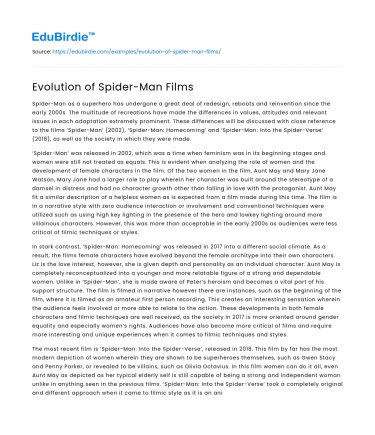Spider-Man as a superhero has undergone a great deal of redesign, reboots and reinvention since the early 2000s. The multitude of recreations have made the differences in values, attitudes and relevant issues in each adaptation extremely prominent. These differences will be discussed with close reference to the films ‘Spider-Man’ (2002), ‘Spider-Man: Homecoming’ and ‘Spider-Man: Into the Spider-Verse’ (2018), as well as the society in which they were made.
‘Spider-Man’ was released in 2002, which was a time when feminism was in its beginning stages and women were still not treated as equals. This is evident when analyzing the role of women and the development of female characters in the film. Of the two women in the film, Aunt May and Mary Jane Watson, Mary Jane had a larger role to play wherein her character was built around the stereotype of a damsel in distress and had no character growth other than falling in love with the protagonist. Aunt May fit a similar description of a helpless women as is expected from a film made during this time. The film is in a narrative style with zero audience interaction or involvement and conventional techniques were utilized such as using high key lighting in the presence of the hero and lowkey lighting around more villainous characters. However, this was more than acceptable in the early 2000s as audiences were less critical of filmic techniques or styles.
Save your time!
We can take care of your essay
- Proper editing and formatting
- Free revision, title page, and bibliography
- Flexible prices and money-back guarantee
In stark contrast, ‘Spider-Man: Homecoming’ was released in 2017 into a different social climate. As a result, the films female characters have evolved beyond the female architype into their own characters. Liz is the love interest, however, she is given depth and personality as an individual character. Aunt May is completely reconceptualized into a younger and more relatable figure of a strong and dependable women. Unlike in ‘Spider-Man’, she is made aware of Peter’s heroism and becomes a vital part of his support structure. The film is filmed in narrative however there are instances, such as the beginning of the film, where it is filmed as an amateur first person recording. This creates an interesting sensation wherein the audience feels involved or more able to relate to the action. These developments in both female characters and filmic techniques are well received, as the society in 2017 is more oriented around gender equality and especially women’s rights. Audiences have also become more critical of films and require more interesting and unique experiences when it comes to filmic techniques and styles.
The most recent film is ‘Spider-Man: Into the Spider-Verse’, released in 2018. This film by far has the most modern depiction of women wherein they are shown to be superheroes themselves, such as Gwen Stacy and Penny Parker, or revealed to be villains, such as Olivia Octavius. In this film women can do it all, even Aunt May as depicted as her typical elderly self is still capable of being a strong and independent woman unlike in anything seen in the previous films. ‘Spider-Man: Into the Spider-Verse’ took a completely original and different approach when it came to filmic style as it is an animated film. The animation style has incorporated multiple genres including classic comic book style, anime, black and white and even the iconic Looney Tunes style animation. This creates for a unique and attention-grabbing viewing experience that is certain to excite modern day audiences in a way that previous films cannot.
It is evident that these films have evolved and adapted to appeal to the current society in which they are operating and do a good job of relating to their respective societies.






 Stuck on your essay?
Stuck on your essay?

